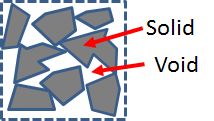The Porosity Percentage calculator computes the porosity percentage based on the total volume and the volume of the voids.
INSTRUCTIONS: Choose units and enter the following:
- (VV) Volume of Voids
- (VTotal) Total Volume
Porosity Percentage (PP): The calculator returns the porosity as a percentage.
The Math / Science
The Porosity Percentage calculator computes the porosity of a medium. The porosity represents the relative amounts of space occupied by the "voids" in a volume of material, where the voids can be a combination of liquids or gases.
This porosity percentage is a measure of how compact the material is. A volume of large rocks will obviously have a great deal of space between them and thus have a large porosity percentage compared to fine particulate of a volume of a clay soil, which would have very limited amounts of voids.
The inputs to this equation are the total sample volume, VTotal, and the volume observed to be occupied by voids VV.

Notes
In engineering application the porosity is used to indicate a tendency of a material to expand or contract. A high porosity percentage is likely to be seen in loose soils which then will contract under pressure or added loads. A low porosity percentage represents a material that is dense. This porosity percentage affects how fluids will flow through a medium or how particulates can move through the medium.